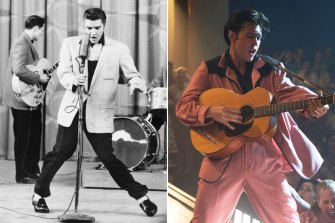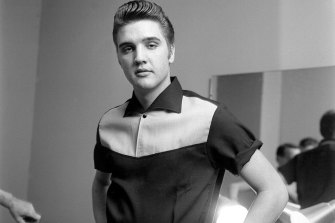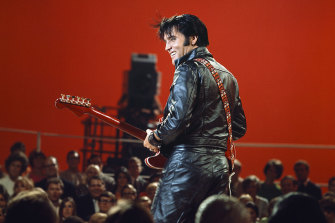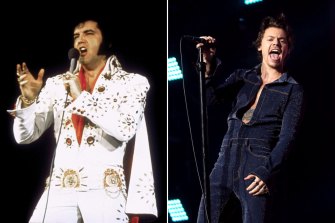There’s a scene in Baz Luhrmann’s astonishing biopic of Elvis Presley in which the petrified young star-on-the-ascent, played with uncanny likeness by emerging talent Austin Butler, is heckled by hillbillies for his effete looks. A charmer in the crowd calls him a “fairy” for his bubblegum pink suit, heavily gel-slicked hair and smokey eyeliner, at which he locks eyes with the audience member and promptly unleashes merry hell on stage, teenage girls overcome with hysteria at his hip-thrusting, lip curling, devilish swagger and magnetic presence. It’s a moment that perfectly encapsulates the fascinating duality of the performer, who’s become more myth than man; on one side all masculine bravado and sexual prowess, on the other a razzmatazz showman who could give Liberace a run for his beadwork.
Elvis Presley, left, in one of his signature suits, and Austin Butler who plays the King in a new biopic. Credit:Getty Images/AP
Elvis, released last week, is already generating Oscars buzz thanks to Luhrmann’s expansive storytelling of The King’s meteoric rise, and tragic fall. Alongside the star wattage of the cast – Tom Hanks as his crooked manager Tom Parker and newcomer Olivia DeJonge as a kittenish Priscilla Presley – one of the most spellbinding aspects is how the clothes created the legend that was Elvis. And in a world of stage managed pop stars and gender-fluid performers who oscillate between men’s and women’s codes of dress, it’s easy to forget that Elvis was playing with gender before Harry Styles even touched a Gucci gown.
“What was remarkable about Elvis was that he wasn’t just a groundbreaker in terms of how he dressed, but the fact that he did all this himself,” says Oscar-winning costume designer and Luhrmann’s wife Catherine Martin. “This was a time before stylists, before artists had people meticulously crafting an image, and it all came from him, this boy from a poor area of Memphis who loved fashion.”
The film sees the young Elvis’s style evolve from crisp white vests and slim fit trousers to pristine suits from the historic Lansky Brothers. Along with his distinctive take on grooming; “he had a very clear idea of how he wanted to look,” says Catherine. “He actually dyed his hair that jet black colour, and applied eyeliner.” Then came the lavishly embellished jumpsuits of the Vegas years, their maximalism and busy aesthetic metaphors for the chaos and complexities of his life at that stage. The clothes made both the man, and the myth.
These are the legendary style choices The King relied on.
The sexy suit
It’s a suit, but not as we know it. Elvis toyed with tailoring by allowing more fluid proportions, all the better for highlighting his physicality on stage and showcasing those hip-thrusting, leg-jerking moves. “There was a sensuality to the way the fabric draped in a very languorous manner across the body, slightly more voluminous on the torso and loose around the leg,” says Martin. “There was a real relationship between his body and the tailoring.” Martin admits she spent “hours and hours” getting the soft flow of the trousers just right, because the main part of his scandalous appeal was what was happening below the waist. “Everything about the cut was done to highlight those little wiggles and mannerisms.” It was a soft-structure approach to suiting that was entirely at odds with the done-up 1950s, and an approach that Armani would later take in the 1980s as part of a seismic shift in men’s suit silhouettes.
The Cuban shirt: a mainstay in Elvis’ wardrobe.Credit:Getty Images
A flamboyant shirt
Of course, one can’t think of Elvis without thinking of those All American, camp collar shirts. The style evolved when curious Americans began adopting the shirt style popular amongst Cuban and South American farm workers – the soft style and wide, spread-open collar was a cooling option for outdoors work in searing temperatures. By the 1950s, it had become associated with an entirely new demographic; the teenager. Elvis’s iterations were wide ranging, from classic versions to his defining Blue Hawaii period – the film charts the stage of his career where he becomes a fast turnover Hollywood star, churning out 31 movies over a nine-year period at the encouragement of his money-hungry manager. The Aloha shirt, as it’s generally known, became part of his fashion lexicon and encouraged a generation of hipsters decades later to don tropical patterns (the style’s still ubiquitous at bi-annual menswear fair Pitti Uomo). Elvis mixed up formal and casual codes by wearing them underneath suiting, the collar over the lapel; again an affectation that’s become a mainstay in men’s style.
Eyeliner and that quiff
Tellingly, whenever Austin Butler’s Elvis needs a moment to compose himself, he studiously combs his hair. This was the burgeoning Brylcreem era, when the concept of men’s grooming was just beginning to register during bathroom ablution routines across America, and Elvis was its poster boy. His carefully teased curl and quiff, artfully combed – and dyed – hair and smudge of bad boy eyeliner were light years ahead of the pack.
Black leather, now a staple of the Paris catwalks, was a controversial choice for Elvis in the 1960s.Credit:Getty Images
Black leathers
There’s a moment in the film where Elvis, after dialling back the TV entertainer kitsch, decides to go back to his rock ‘n’ roll roots and settles on a leather jacket as part of his new look. “Black and bad” are the requirements, as he tries to return to his scandalous, punkish roots. “Elvis was outrageous, he was a rebel, he frightened conservative America,” says Martin of the moral outrage hurled at the singer from the McCarthy-era Right wing; a storm that gathered so much force that Elvis was arrested and had to sign up for active duty. The jacket was a return to that rebellious era, associated with a sort of renegade free-thinker, as typified by James Dean and Jack Kerouac’s On The Road. Elvis had followed in the former’s footsteps by playing a biker in the 1964 film Roustabout. Worn with creaking leather trousers, it was the hardened armour he needed to try to reboot his career. Today it’s a mainstay of the cult Paris catwalks of Celine and Saint Laurent.
Working a belt
“Belts are an instant sign that Elvis is in the building,” says Martin, so much so that the film’s poster is a close-up of a belt with the singer’s name inside. Like his jumpsuit, they were another outlet for glorious decoration and adding a touch of OTT maximalism on a hitherto standard, functional accessory. In a more tragic sense, the belts – by virtue of their placement across the waist – also served to highlight his declining health and struggles with weight.
Singer Harry Styles owes his flamboyant style to Elvis.Credit:Getty Images
The all-out jumpsuit
Harry Styles might have adopted a spangly Gucci number on stage recently, but he owes the jumpsuit – and a great deal more of what he wears – to the original showman. “What I find fascinating about Elvis is the fact that he loved all this decoration and adornment, and was very camp in how he dressed, but you never for a second question his masculinity,” says Martin. In the film, a young Elvis turns to comic book heroes to escape turmoil at home; later in life, facing financial ruin and a failed marriage, he encased himself in a superhero costume in the form of the jumpsuit to maintain an otherworldly image when so much was going awry. The jumpsuit for men became the archetypal showman attire, but it was Elvis who did it first.
The Telegraph, London
Make the most of your health, relationships, fitness and nutrition with our Live Well newsletter. Get it in your inbox every Monday.
Most Viewed in Lifestyle
From our partners
Source: Read Full Article



